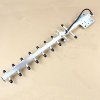flippineck
- Sep 8, 2013
- 358
- Joined
- Sep 8, 2013
- Messages
- 358
Here is my local (UK) cell tower:
Station Type: Macrocell
Height of Antenna: 13.7 Metres
Frequency Range: 2100 MHz
Transmitter Power: 17.89 dBW
Maximum licensed power: 35 dBW
Type of Transmission: UMTS
It's no more than a mile away. There are no very major obstructions to line of sight but, there is some moderately raised ground, trees, a few houses etc. between the mast and my roof.
I'm using a 10 element Yagi-Uda antenna (8 directors, one driven element, one reflector) designed for 2100MHz connected to my 3G router via less than 1 metre of RG58 coax & some SMA connectors.
Having trouble getting a good signal especially when the weather's wet. I've tried repositioning the antenna including outdoors, remaking the connections, shortening the coax as much as possible.
I did notice something that strikes me as odd about the (Chinese-made) antenna. The boom of the antenna is made of square section aluminium hollow bar. The directors and the reflector are all made of aluminium tube. They all fit into holes drilled in the boom, and are then held in place by 'crimps' made in the side of the boom.
This would mean that electrically, every director and the reflector, are all shorted together at their midpoints by the boom.
I tend to think in DC and very low frequency AC terms, high frequencies get too esoteric and mathematical for me.. so maybe this design is perfectly ok given the whole thing is designed to do what it does at 2100MHz.
Maybe it's just a load of rubbish simply designed to 'look the part' though?
Need to pick the brains of someone who's into radio stuff here I think?
Attached: representative image - not my antenna but one very similar
Station Type: Macrocell
Height of Antenna: 13.7 Metres
Frequency Range: 2100 MHz
Transmitter Power: 17.89 dBW
Maximum licensed power: 35 dBW
Type of Transmission: UMTS
It's no more than a mile away. There are no very major obstructions to line of sight but, there is some moderately raised ground, trees, a few houses etc. between the mast and my roof.
I'm using a 10 element Yagi-Uda antenna (8 directors, one driven element, one reflector) designed for 2100MHz connected to my 3G router via less than 1 metre of RG58 coax & some SMA connectors.
Having trouble getting a good signal especially when the weather's wet. I've tried repositioning the antenna including outdoors, remaking the connections, shortening the coax as much as possible.
I did notice something that strikes me as odd about the (Chinese-made) antenna. The boom of the antenna is made of square section aluminium hollow bar. The directors and the reflector are all made of aluminium tube. They all fit into holes drilled in the boom, and are then held in place by 'crimps' made in the side of the boom.
This would mean that electrically, every director and the reflector, are all shorted together at their midpoints by the boom.
I tend to think in DC and very low frequency AC terms, high frequencies get too esoteric and mathematical for me.. so maybe this design is perfectly ok given the whole thing is designed to do what it does at 2100MHz.
Maybe it's just a load of rubbish simply designed to 'look the part' though?
Need to pick the brains of someone who's into radio stuff here I think?
Attached: representative image - not my antenna but one very similar
Attachments
Last edited:







